Ti3C2@g-C3N4/TiO2 Ternary Heterogeneous Photocatalyst for Promoted Photocatalytic Degradation Activities
Abstract
1. Introduction
2. Materials and Methods
2.1. Chemicals
2.2. Synthesis of Catalysts
2.2.1. Synthesis of TBCN
2.2.2. Synthesis of Ti3C2
2.2.3. Synthesis of TC-TBCN
2.3. Characterization
2.4. Photocatalytic Performance Measurements
3. Results
3.1. Structure Characterization
3.1.1. Structure and Composition of Ti3C2
3.1.2. Structure and Composition of TC-TBCN
3.1.3. N2 Sorption Isotherms and Pore Size Distributions
3.1.4. Optical Absorption Performances of the Samples
3.2. Photocatalytic Activity
4. Discussion
5. Conclusions
Author Contributions
Funding
Institutional Review Board Statement
Informed Consent Statement
Data Availability Statement
Acknowledgments
Conflicts of Interest
References
- Cai, Y.; Sun, T.; Li, G.; An, T. Traditional and emerging water disinfection technologies challenging the control of antibiotic-resistant bacteria and antibiotic resistance genes. ACS EST Eng. 2021, 1, 1046–1064. [Google Scholar] [CrossRef]
- Xu, J.J.; Gu, H.Y.; Chen, M.D.; Li, X.P.; Zhao, H.W.; Yang, H.B. Dual Z-scheme Bi3TaO7/Bi2S3/SnS2 photocatalyst with high performance for Cr(VI) reduction and TC degradation under visible light irradiation. Rare Met. 2022, 41, 2417–2428. [Google Scholar] [CrossRef]
- Wang, Z.; Xu, S.; Cai, J.; Ma, J.; Zhao, G. Perspective on photoelectrocatalytic removal of refractory organic pollutants in water systems. ACS EST Eng. 2022, 2, 1001–1014. [Google Scholar] [CrossRef]
- Cheng, Y.; Cao, T.; Xiao, Z.G.; Zhu, H.J.; Yu, M. Photocatalytic treatment of methyl orange dye wastewater by porous floating ceramsite loaded with cuprous oxide. Coatings 2022, 12, 286. [Google Scholar] [CrossRef]
- Chen, Z.; Jin, J.; Song, X.; Wei, S.; Zhang, L.; Zhang, S. Effects of low-molecular-weight organics on the photoreduction of bromate in water. ACS EST Eng. 2021, 1, 581–590. [Google Scholar] [CrossRef]
- Liu, H.; Li, X.X.; Liu, X.Y.; Ma, Z.H.; Yin, Z.Y.; Yang, W.W.; Yu, Y.S. Schiff-base-rich g-CxN4 supported PdAg nanowires as an efficient Mott-Schottky catalyst boosting photocatalytic dehydrogenation of formic acid. Rare Met. 2021, 40, 808–816. [Google Scholar] [CrossRef]
- Kamoun, O.; Gassoumi, A.; Shkir, M.; Gorji, N.E.; Turki-Kamoun, N. Synthesis and characterization of highly photocatalytic active Ce and Cu co-doped novel spray pyrolysis developed MoO3 films for photocatalytic degradation of Eosin-Y dye. Coatings 2022, 12, 823. [Google Scholar] [CrossRef]
- Liu, X.; Huang, W.-Y.; Zhou, Q.; Chen, X.-R.; Yang, K.; Li, D.; Dionysiou, D.D. Ag-decorated 3D flower-like Bi2MoO6/rGO with boosted photocatalytic performance for removal of organic pollutants. Rare Met. 2020, 40, 1086–1098. [Google Scholar] [CrossRef]
- He, S.; Chen, Y.; Li, X.; Zeng, L.; Zhu, M. Heterogeneous photocatalytic activation of persulfate for the removal of organic contaminants in water: A critical review. ACS EST Eng. 2022, 2, 527–546. [Google Scholar] [CrossRef]
- Hunge, Y.M.; Yadav, A.A.; Kang, S.W.; Kim, H. Facile synthesis of multitasking composite of Silver nanoparticle with Zinc oxide for 4-nitrophenol reduction, photocatalytic hydrogen production, and 4-chlorophenol degradation. J. Alloys Compd. 2022, 928, 167133. [Google Scholar] [CrossRef]
- He, Z.; Zhang, J.; Li, X.; Guan, S.; Dai, M.; Wang, S. 1D/2D heterostructured photocatalysts: From design and unique properties to their environmental applications. Small 2020, 16, 2005051. [Google Scholar] [CrossRef]
- Zhang, S.; He, Z.; Li, X.; Zhang, J.; Zang, Q.; Wang, S. Building heterogeneous nanostructures for photocatalytic ammonia decomposition. Nanoscale Adv. 2020, 2, 3610–3623. [Google Scholar] [CrossRef] [PubMed]
- Dai, M.; He, Z.; Zhang, P.; Li, X.; Wang, S. ZnWO4-ZnIn2S4 S-scheme heterojunction for enhanced photocatalytic H2 evolution. J. Mater. Sci. Technol. 2022, 122, 231–242. [Google Scholar] [CrossRef]
- Zhang, G.; Ruan, J.; Du, T. Recent advances on photocatalytic and electrochemical oxidation for ammonia treatment from water/wastewater. ACS EST Eng. 2021, 1, 310–325. [Google Scholar] [CrossRef]
- Tonda, S.; Kumar, S.; Bhardwaj, M.; Yadav, P.; Ogale, S. g-C3N4/NiAl-LDH 2D/2D hybrid heterojunction for high-performance photocatalytic reduction of CO2 into renewable fuels. ACS Appl. Mater. Interfaces 2018, 10, 2667–2678. [Google Scholar] [CrossRef] [PubMed]
- Zhang, S.; Dai, M.; Guo, J.; Wang, G.; Wang, S.; He, Z. Stable Ti3+ in B-TiO2/BN based hybrids for efficient photocatalytic reduction. Chem. Eng. J. Adv. 2022, 11, 100333. [Google Scholar] [CrossRef]
- Liu, D.; Zhang, S.; Wang, J.; Peng, T.; Li, R. Direct Z-Scheme 2D/2D photocatalyst based on ultrathin g-C3N4 and WO3 nanosheets for efficient visible-light-driven H2 generation. ACS Appl. Mater. Interfaces 2019, 11, 27913–27923. [Google Scholar] [CrossRef]
- Dai, M.; He, Z.; Cao, W.; Zhang, J.; Chen, W.; Jin, Q.; Que, W.; Wang, S. Rational construction of S-scheme BN/MXene/ZnIn2S4 heterojunction with interface engineering for efficient photocatalytic hydrogen production and chlorophenols degradation. Sep. Purif. Technol. 2023, 309, 123004. [Google Scholar] [CrossRef]
- Saleem, Z.; Pervaiz, E.; Yousaf, M.U.; Niazi, M.B.K. Two-dimensional materials and composites as potential water splitting photocatalysts: A review. Catalysts 2020, 10, 464. [Google Scholar] [CrossRef]
- Ngullie, R.C.; Alaswad, S.O.; Bhuvaneswari, K.; Shanmugam, P.; Pazhanivel, T.; Arunachalam, P. Synthesis and characterization of efficient ZnO/g-C3N4 nanocomposites photocatalyst for photocatalytic degradation of methylene bue. Coatings 2020, 10, 500. [Google Scholar] [CrossRef]
- Yu, H.; Dai, M.; Zhang, J.; Chen, W.; Jin, Q.; Wang, S.; He, Z. Interface engineering in 2D/2D heterogeneous photocatalysts. Small 2022, 19, 2205767. [Google Scholar] [CrossRef] [PubMed]
- Ren, D.; Liang, Z.; Ng, Y.H.; Zhang, P.; Xiang, Q.; Li, X. Strongly coupled 2D-2D nanojunctions between P-doped Ni2S (Ni2SP) cocatalysts and CdS nanosheets for efficient photocatalytic H2 evolution. Chem. Eng. J. 2020, 390, 124496. [Google Scholar] [CrossRef]
- Shen, R.C.; Zhang, L.P.; Chen, X.Z.; Jaroniec, M.; Li, N.; Li, X. Integrating 2D/2D CdS/alpha-Fe2O3 ultrathin bilayer Z-scheme heterojunction with metallic beta-NiS nanosheet-based ohmic junction for efficient photocatalytic H2 evolution. Appl. Catal. B-Environ. 2020, 266, 118619. [Google Scholar] [CrossRef]
- He, Z.; Kim, C.; Lin, L.H.; Jeon, T.H.; Lin, S.; Wang, X.C.; Choi, W. Formation of heterostructures via direct growth CN on h-BN porous nanosheets for metal-free photocatalysis. Nano Energy 2017, 42, 58–68. [Google Scholar] [CrossRef]
- Zhou, A.Q.; Yang, J.M.; Zhu, X.W.; Zhu, X.L.; Liu, J.Y.; Zhong, K.; Chen, H.X.; Chu, J.Y.; Du, Y.S.; Song, Y.H.; et al. Self-assembly construction of NiCo LDH/ultrathin g-C3N4 nanosheets photocatalyst for enhanced CO2 reduction and charge separation mechanism study. Rare Met. 2022, 41, 2118–2128. [Google Scholar] [CrossRef]
- Zhang, S.J.; He, Z.L.; Xu, S.S.; Li, X.; Zhang, J.; Zhan, X.P.; Dai, M.; Wang, S.G. In situ liquid-phase growth strategies of g-C3N4 solar-driven heterogeneous catalysts for environmental applications. Solar RRL 2021, 5, 2100233. [Google Scholar] [CrossRef]
- Liao, Y.-W.; Yang, J.; Wang, G.-H.; Wang, J.; Wang, K.; Yan, S.D. Hierarchical porous NiO as a noble-metal-free cocatalyst for enhanced photocatalytic H2 production of nitrogen-deficient g-C3N4. Rare Met. 2021, 41, 396–405. [Google Scholar] [CrossRef]
- Shen, R.C.; Liu, W.; Ren, D.D.; Xie, J.; Li, X. Co1.4Ni0.6P cocatalysts modified metallic carbon black/g-C3N4 nanosheet Schottky heterojunctions for active and durable photocatalytic H2 production. Appl. Surf. Sci. 2019, 466, 393–400. [Google Scholar] [CrossRef]
- Zhang, X.; Li, M.J.; Liu, C.; Zhang, Z.Y.; Zhang, F.C.; Liu, Q.P. Enhanced the efficiency of photocatalytic degradation of methylene blue by construction of Z-scheme g-C3N4/BiVO4 heterojunction. Coatings 2021, 11, 1027. [Google Scholar] [CrossRef]
- Akhundi, A.; Moshfegh, A.Z.; Habibi-Yangjeh, A.; Sillanpaa, M. Simultaneous dual-functional photocatalysis by g-C3N4-based nanostructures. ACS EST Eng. 2022, 2, 564–585. [Google Scholar] [CrossRef]
- Fernandez-Catala, J.; Greco, R.; Navlani-Garcia, M.; Cao, W.; Berenguer-Murcia, A.; Cazorla-Amoros, D. g-C3N4-based direct Z-scheme photocatalysts for environmental applications. Catalysts 2022, 12, 1137. [Google Scholar] [CrossRef]
- Cheng, L.; Zhang, H.; Li, X.; Fan, J.; Xiang, Q. Carbon-graphitic carbon nitride hybrids for heterogeneous photocatalysis. Small 2021, 17, 2005231. [Google Scholar] [CrossRef]
- Zhang, Y.; Zhao, S.M.; Su, Q.W.; Xu, J.L. Visible light response ZnO-C3N4 thin film photocatalyst. Rare Met. 2021, 40, 96–104. [Google Scholar] [CrossRef]
- Dao, D.Q.; Nguyen, T.K.A.; Pham, T.T.; Shin, E.W. Synergistic effect on photocatalytic activity of Co-doped NiTiO3/g-C3N4 composites under visible light irradiation. Catalysts 2020, 10, 1332. [Google Scholar] [CrossRef]
- Yan, R.; Zada, A.; Sun, L.; Li, Z.J.; Mu, Z.Y.; Chen, S.Y.; Yang, F.; Sun, J.H.; Bai, L.L.; Qu, Y.; et al. Comparative study of metal oxides and phosphate modification with different mechanisms over g-C3N4 for visible-light photocatalytic degradation of metribuzin. Rare Met. 2021, 41, 155–165. [Google Scholar] [CrossRef]
- Koci, K.; Reli, M.; Troppova, I.; Sihor, M.; Bajcarova, T.; Ritz, M.; Pavlovsky, J.; Praus, P. Photocatalytic decomposition of N2O by using nanostructured graphitic carbon nitride/zinc oxide photocatalysts immobilized on foam. Catalysts 2019, 9, 735. [Google Scholar] [CrossRef]
- Zhang, H.; Li, L.; Li, Q.Q.; Ma, T.; Gao, J.Q.; Xue, J.B.; Gao, S. Graphitic carbon nitride loaded with bismuth nanoparticles displays antibacterial photocatalytic activity. Rare Met. 2022, 41, 1570–1582. [Google Scholar] [CrossRef]
- Li, Y.; Zhang, M.Q.; Liu, Y.F.; Zhao, Q.H.; Li, X.; Zhou, Q.Y.; Chen, Y.F.; Wang, S.F. Construction of bronze TiO2/Ti3C2 MXene/Ag3PO4 ternary composite photocatalyst toward high photocatalytic performance. Catalysts 2022, 12, 599. [Google Scholar] [CrossRef]
- Xiao, L.H.; Li, X.; Zhang, J.; He, Z.L. MgB4 MXene-like nanosheets for photocatalytic hydrogen evolution. ACS Appl. Nano Mater. 2021, 4, 12779–12787. [Google Scholar] [CrossRef]
- Zhang, S.; Zhang, M.; Xiong, W.; Long, J.; Xu, Y.; Yang, L.; Dai, W. Constructing active sites on self-supporting Ti3C2Tx (T = OH) nanosheets for enhanced photocatalytic CO2 reduction into alcohols. Catalysts 2022, 12, 1594. [Google Scholar] [CrossRef]
- You, Z.; Liao, Y.; Li, X.; Fan, J.; Xiang, Q. State-of-the-art recent progress in MXene-based photocatalysts: A comprehensive review. Nanoscale 2021, 13, 9463–9504. [Google Scholar] [CrossRef]
- Li, Y.; Yang, Y.L.; Chen, G.; Fan, J.J.; Xiang, Q.J. Au cluster anchored on TiO2/Ti3C2 hybrid composites for efficient photocatalytic CO2 reduction. Rare Met. 2022, 41, 3045–3059. [Google Scholar] [CrossRef]
- Govindan, B.; Madhu, R.; Abu Haija, M.; Kusmartsev, F.V.; Banat, F. Pd-decorated 2D MXene (2D Ti3C2Tx) as a high-performance electrocatalyst for reduction of carbon dioxide into fuels toward llimate change mitigation. Catalysts 2022, 12, 1180. [Google Scholar] [CrossRef]
- Wang, Z.; Yu, K.; Gong, S.; Mao, H.; Huang, R.; Zhu, Z. Cu3BiS3/MXenes with Excellent Solar-Thermal Conversion for Continuous and Efficient Seawater Desalination. ACS Appl. Mater. Interfaces 2021, 13, 16246–16258. [Google Scholar] [CrossRef]
- Yang, Y.; Zhang, D.; Fan, J.; Liao, Y.; Xiang, Q. Construction of an ultrathin S-Scheme heterojunction based on few-layer g-C3N4 and monolayer Ti3C2Tx MXene for photocatalytic CO2 reduction. Solar RRL 2020, 5, 2000351. [Google Scholar] [CrossRef]
- Li, Y.; Zhang, D.; Feng, X.; Liao, Y.; Wen, Q.; Xiang, Q. Truncated octahedral bipyramidal TiO2/MXene Ti3C2 hybrids with enhanced photocatalytic H2 production activity. Nanoscale Adv. 2019, 1, 1812–1818. [Google Scholar] [CrossRef] [PubMed]
- Ta, Q.T.H.; Tran, N.M.; Noh, J.S. Rice crust-like ZnO/Ti3C2Tx MXene hybrid structures for improved photocatalytic activity. Catalysts 2020, 10, 1140. [Google Scholar] [CrossRef]
- Huang, G.M.; Li, S.Z.; Liu, L.J.; Zhu, L.F.; Wang, Q. Ti3C2 MXene-modified Bi2WO6 nanoplates for efficient photodegradation of volatile organic compounds. Appl. Surf. Sci. 2020, 503, 144183. [Google Scholar] [CrossRef]
- Cai, T.; Wang, L.L.; Liu, Y.T.; Zhang, S.Q.; Dong, W.Y.; Chen, H.; Yi, X.Y.; Yuan, J.L.; Xia, X.N.; Liu, C.B.; et al. Ag3PO4/Ti3C2 MXene interface materials as a Schottky catalyst with enhanced photocatalytic activities and anti-photocorrosion performance. Appl. Catal. B-Environ. 2018, 239, 545–554. [Google Scholar] [CrossRef]
- Zhao, C.; Yang, X.; Han, C.; Xu, J. Sacrificial agent-free photocatalytic oxygen evolution from water splitting over Ag3PO4 /MXene hybrids. Solar RRL 2019, 4, 1900434. [Google Scholar] [CrossRef]
- Wang, J.H.; Shen, Y.F.; Liu, S.Q.; Zhang, Y.J. Single 2D MXene precursor-derived TiO2 nanosheets with a uniform decoration of amorphous carbon for enhancing photocatalytic water splitting. Appl. Catal. B-Environ. 2020, 270, 118885. [Google Scholar] [CrossRef]
- Low, J.X.; Zhang, L.Y.; Tong, T.; Shen, B.J.; Yu, J.G. TiO2/MXene Ti3C2 composite with excellent photocatalytic CO2 reduction activity. J. Catal. 2018, 361, 255–266. [Google Scholar] [CrossRef]
- He, F.; Zhu, B.C.; Cheng, B.; Yu, J.G.; Ho, W.K.; Macyk, W. 2D/2D/0D TiO2/C3N4/Ti3C2 MXene composite S-scheme photocatalyst with enhanced CO2 reduction activity. Appl. Catal. B-Environ. 2020, 272, 119006. [Google Scholar] [CrossRef]
- Zhang, X.M.; Nie, J.L.; Rao, F.; Liu, H.X.; Wang, Y.J.; Qu, D.Y.; Wu, W.W.; Zhong, P.; Zhu, G.Q. Ti3C2@TiO2/g-C3N4 heterojunction photocatalyst with improved charge transfer for enhancing visible-light NO selective removal. Ceram. Int. 2021, 47, 31302–31310. [Google Scholar] [CrossRef]
- Chang, B.; Guo, Y.; Wu, D.; Li, L.; Yang, B.; Wang, J. Plasmon-enabled N2 photofixation on partially reduced Ti3C2 MXene. Chem. Sci. 2021, 12, 11213–11224. [Google Scholar] [CrossRef]
- Sun, C.; Chen, Z.; Cui, J.; Li, K.; Qu, H.; Xie, H.; Zhong, Q. Site-exposed Ti3C2 MXene anchored in N-defect g-C3N4 heterostructure nanosheets for efficient photocatalytic N2 fixation. Catal. Sci. Technol. 2021, 11, 1027–1038. [Google Scholar] [CrossRef]
- Wei, H.; Jiang, Q.; Ampelli, C.; Chen, S.; Perathoner, S.; Liu, Y.; Centi, G. Enhancing N2 fixation activity by converting Ti3C2 MXenes nanosheets to nanoribbons. ChemSusChem 2020, 13, 5614–5619. [Google Scholar] [CrossRef]
- Yu, H.; Xu, S.; Zhang, S.; Wang, S.; He, Z. In-situ construction of core–shell structured TiB2-TiO2@g-C3N4 for efficient photocatalytic degradation. Appl. Surf. Sci. 2022, 579, 152201. [Google Scholar] [CrossRef]
- Liu, Q.; Tan, X.; Wang, S.; Ma, F.; Znad, H.; Shen, Z.; Liu, L.; Liu, S. MXene as a non-metal charge mediator in 2D layered CdS@Ti3C2@TiO2 composites with superior Z-scheme visible light-driven photocatalytic activity. Environ. Sci. Nano 2019, 6, 3158–3169. [Google Scholar] [CrossRef]
- Yang, C.; Tan, Q.Y.; Li, Q.; Zhou, J.; Fan, J.J.; Li, B.; Sun, J.; Lv, K.L. 2D/2D Ti3C2 MXene/g-C3N4 nanosheets heterojunction for high efficient CO2 reduction photocatalyst: Dual effects of urea. Appl. Catal. B-Environ. 2020, 268, 118738. [Google Scholar] [CrossRef]
- Chen, L.; Ye, X.Y.; Chen, S.; Ma, L.; Wang, Z.P.; Wang, Q.T.; Hua, N.B.; Xiao, X.Q.; Cai, S.G.; Liu, X.H. Ti3C2 MXene nanosheet/TiO2 composites for efficient visible light photocatalytic activity. Ceram. Int. 2020, 46, 25895–25904. [Google Scholar] [CrossRef]
- Zhao, G.; Lv, H.; Zhou, Y.; Zheng, X.; Wu, C.; Xu, C. Self-assembled sandwich-like mXene-derived nanocomposites for enhanced electromagnetic wave absorption. ACS Appl. Mater. Interfaces 2018, 10, 42925–42932. [Google Scholar] [CrossRef] [PubMed]
- Hu, T.; Wang, J.; Zhang, H.; Li, Z.; Hu, M.; Wang, X. Vibrational properties of Ti3C2 and Ti3C2T2 (T = O, F, OH) monosheets by first-principles calculations: A comparative study. Phys. Chem. Chem. Phys. 2015, 17, 9997–10003. [Google Scholar] [CrossRef] [PubMed]
- Liu, A.; Gao, M.; Ren, X.; Meng, F.; Yang, Y.; Yang, Q.; Guan, W.; Gao, L.; Liang, X.; Ma, T. A two-dimensional Ru@MXene catalyst for highly selective ambient electrocatalytic nitrogen reduction. Nanoscale 2020, 12, 10933–10938. [Google Scholar] [CrossRef] [PubMed]
- Tanvir, A.; Sobolčiak, P.; Popelka, A.; Mrlik, M.; Spitalsky, Z.; Micusik, M.; Prokes, J.; Krupa, I. Electrically conductive, transparent polymeric nanocomposites modified by 2D Ti3C2Tx (MXene). Polymers 2019, 11, 1272. [Google Scholar] [CrossRef] [PubMed]
- Feng, Y.B.; Du, Y.; Du, M.X.; Li, Z.F.; He, Z.L.; Yang, K.; Lv, X.J.; Jiang, N.; Liu, Y. Facile constructing novel 3D porous g-C3N4/BiOBr0.2I0.8 hybrids: Efficient charge separation for visible-light photocatalysis. J. Alloys Compd. 2018, 767, 241–252. [Google Scholar] [CrossRef]
- He, Z.; Que, W.; Chen, J.; He, Y.; Wang, G. Surface chemical analysis on the carbon-doped mesoporous TiO2 photocatalysts after post-thermal treatment: XPS and FTIR characterization. J. Phys. Chem. Solids 2013, 74, 924–928. [Google Scholar] [CrossRef]
- Cho, Y.-J.; Kim, H.-i.; Lee, S.; Choi, W. Dual-functional photocatalysis using a ternary hybrid of TiO2 modified with graphene oxide along with Pt and fluoride for H2-producing water treatment. J. Catal. 2015, 330, 387–395. [Google Scholar] [CrossRef]
- Cui, S.-S.; Liu, X.; Shi, Y.-B.; Ding, M.-Y.; Yang, X.-F. Construction of atomic-level charge transfer channel in Bi12O17Cl2/MXene heterojunctions for improved visible-light photocatalytic performance. Rare Met. 2022, 41, 2405–2416. [Google Scholar] [CrossRef]
- Jiang, Z.; Chen, Q.; Zheng, Q.; Shen, R.; Zhang, P.; Li, X. Constructing 1D/2D schottky-based heterojunctions between Mn0.2Cd0.8S nanorods and Ti3C2 nanosheets for boosted photocatalytic H2 evolution. Acta Phys.-Chim. Sin. 2021, 37, 2010059. [Google Scholar]
- Bai, J.; Shen, R.; Chen, W.; Xie, J.; Zhang, P.; Jiang, Z.; Li, X. Enhanced photocatalytic H2 evolution based on a Ti3C2/Zn0.7Cd0.3S/Fe2O3 Ohmic/S-scheme hybrid heterojunction with cascade 2D coupling interfaces. Chem. Eng. J. 2022, 429, 132587. [Google Scholar] [CrossRef]
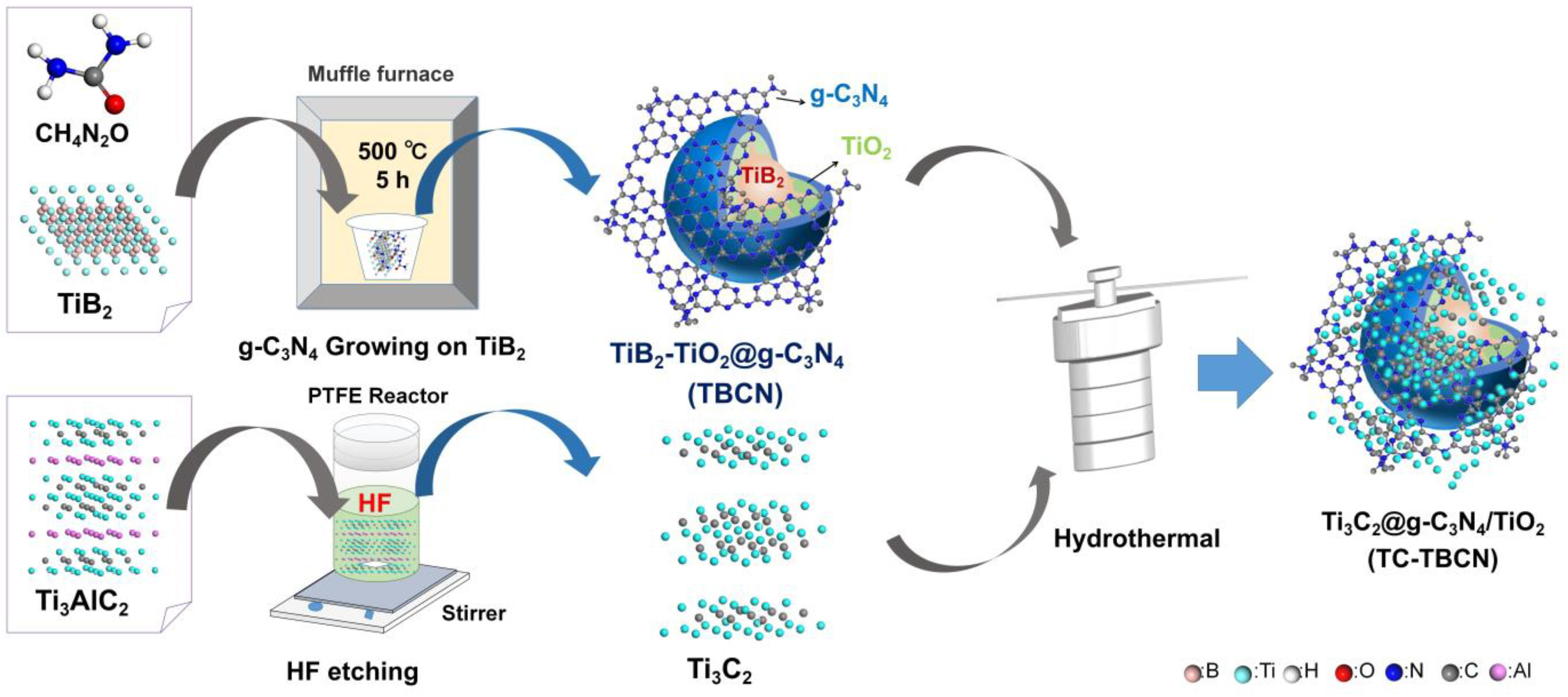
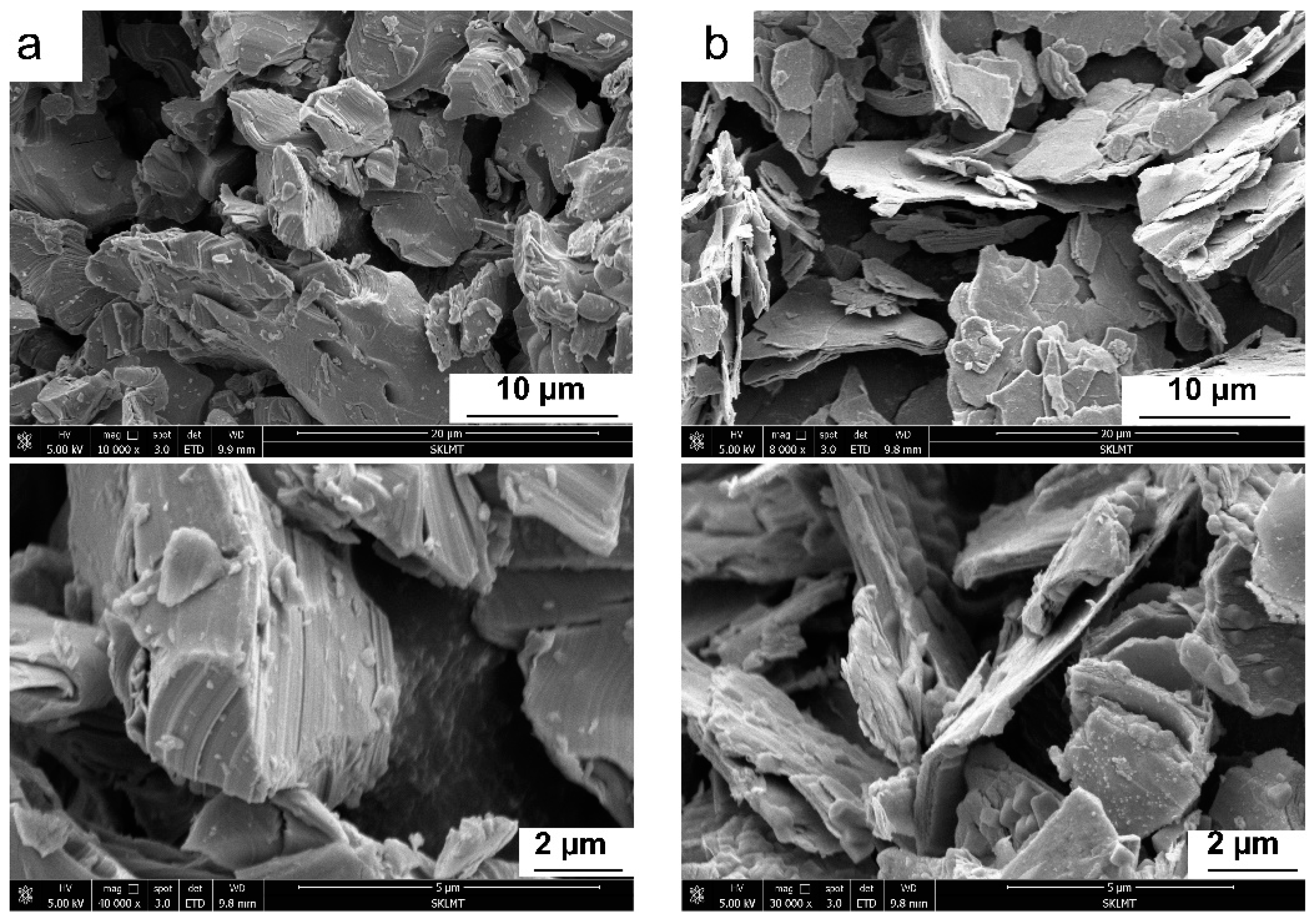




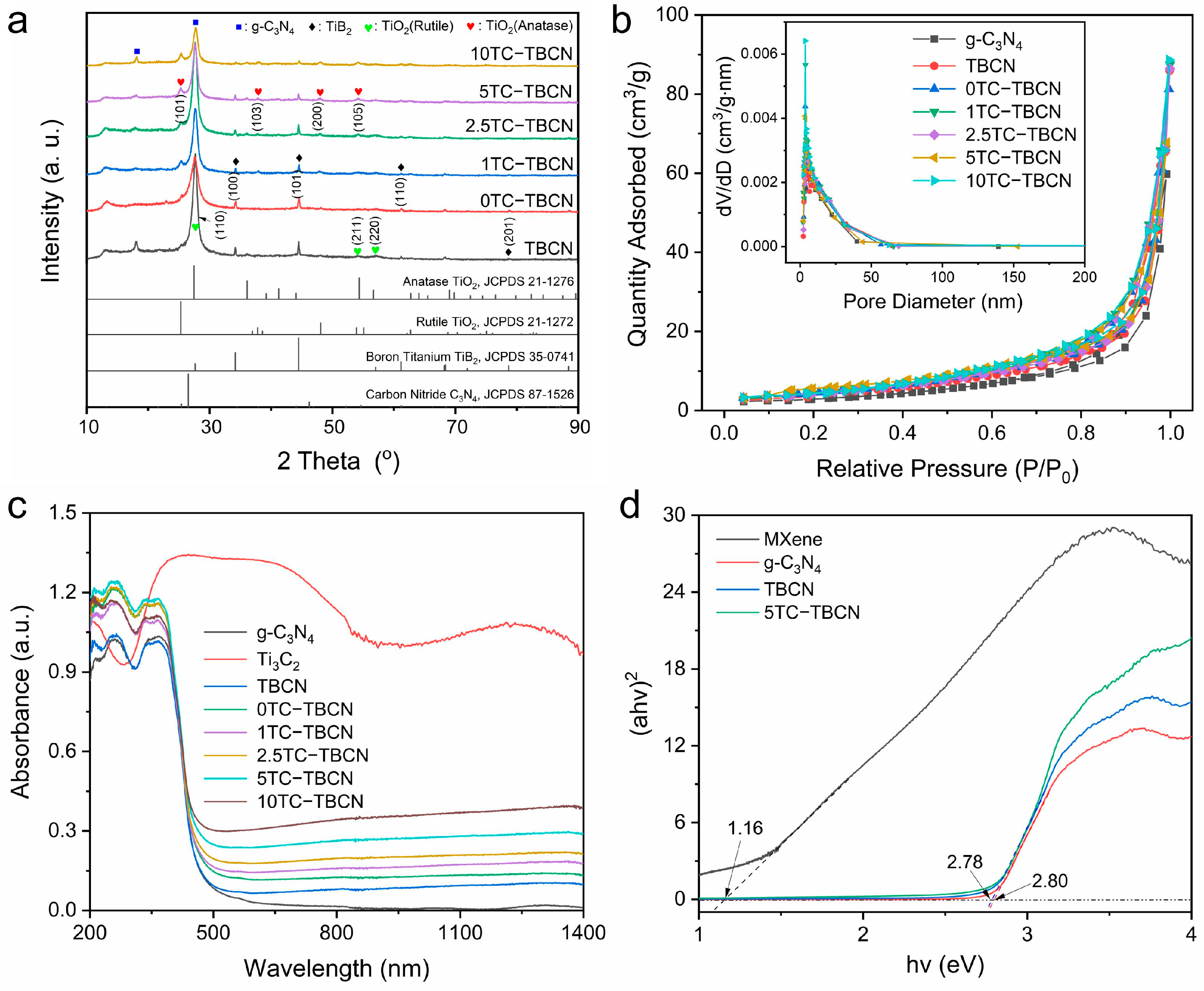


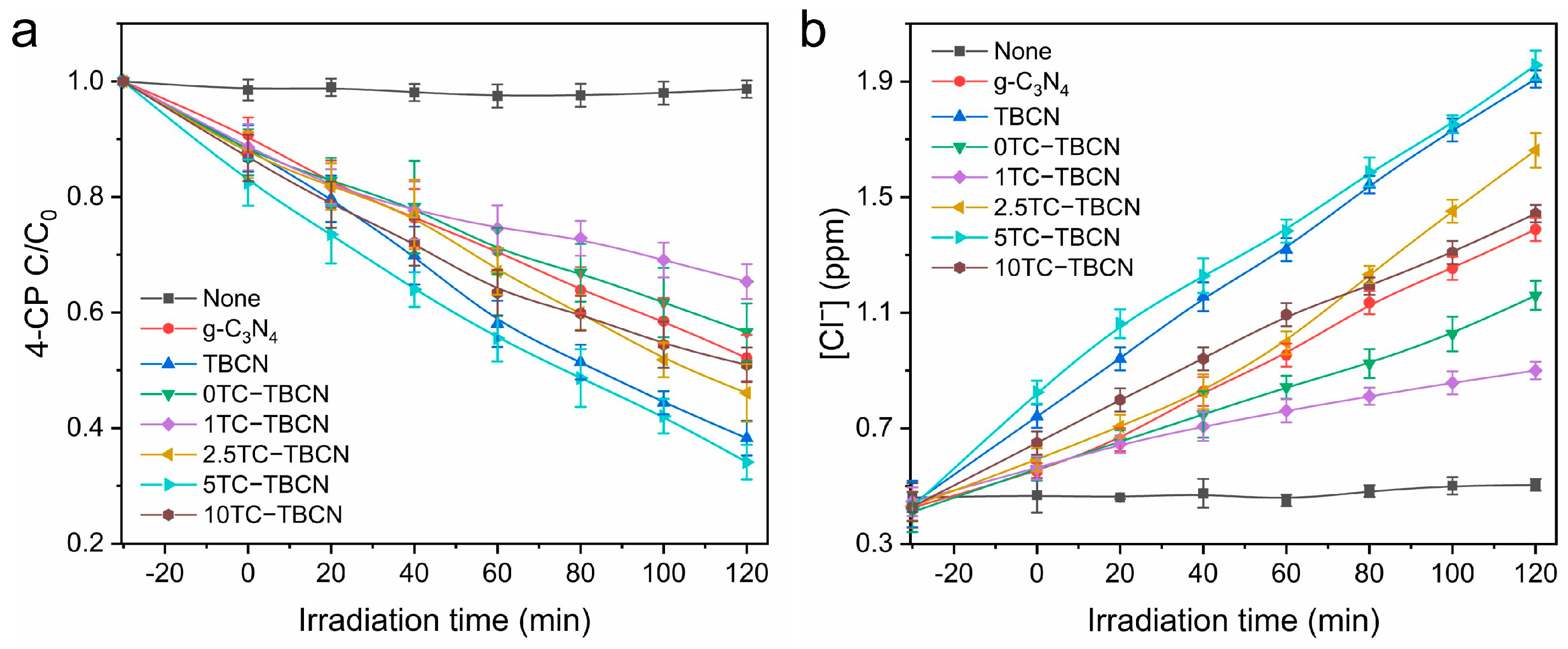
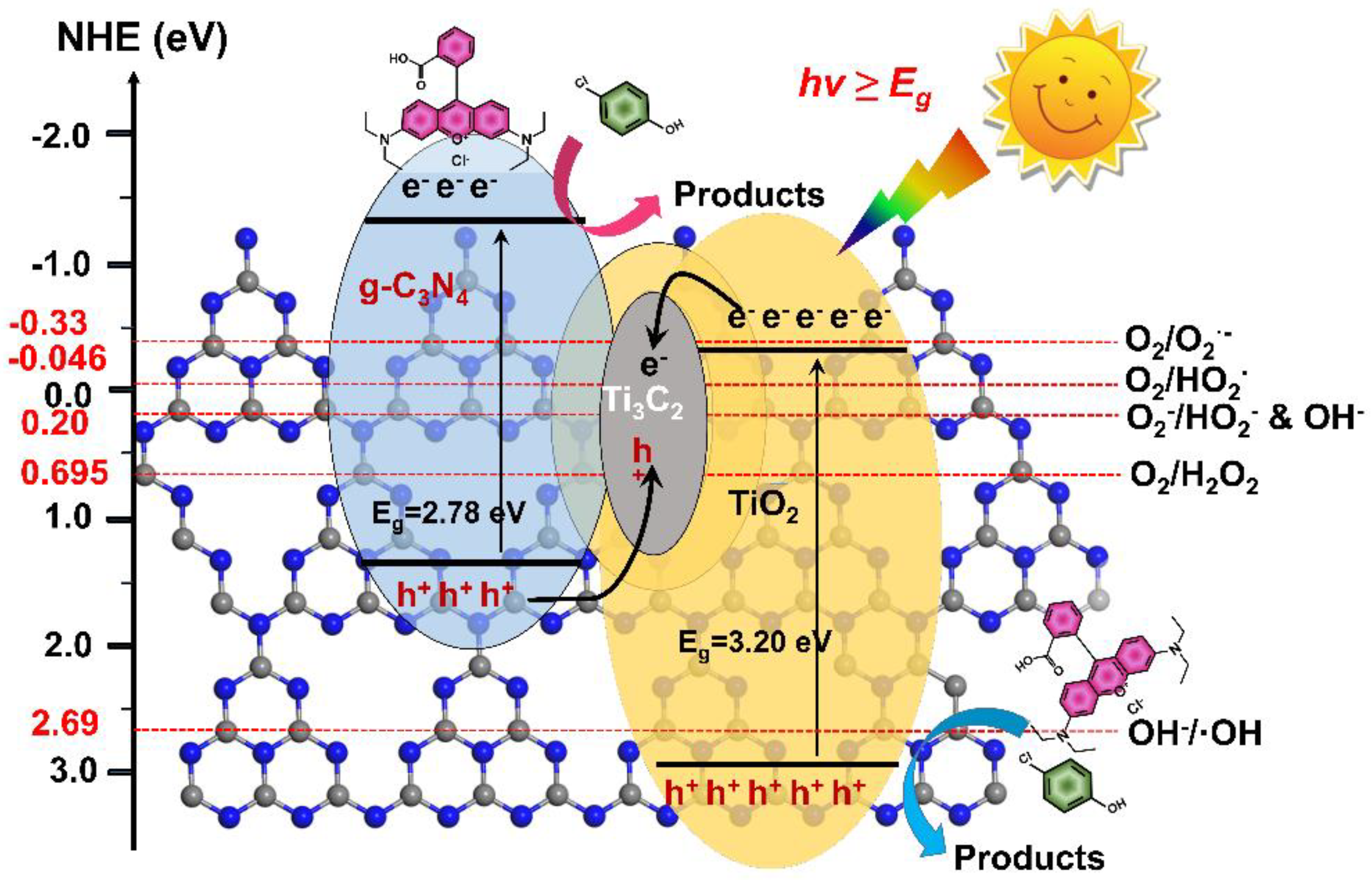
| Sample | BET Surface Area (m2/g) | Total Pore Volume (cm3/g) | Average Pore Size (nm) |
|---|---|---|---|
| g-C3N4 | 10.937 | 0.096 | 5.223 |
| TBCN | 17.384 | 0.138 | 3.650 |
| 0TC-TBCN | 16.829 | 0.129 | 3.626 |
| 1TC-TBCN | 17.231 | 0.140 | 3.788 |
| 2.5TC-TBCN | 16.156 | 0.137 | 3.728 |
| 5TC-TBCN | 22.034 | 0.106 | 3.447 |
| 10TC-TBCN | 15.828 | 0.142 | 3.659 |
| Sample | k |
|---|---|
| g-C3N4 | 0.0104 |
| TBCN | 0.01312 |
| 0TC-TBCN | 0.00974 |
| 1TC-TBCN | 0.01202 |
| 2.5TC-TBCN | 0.01291 |
| 5TC-TBCN | 0.01575 |
| 10TC-TBCN | 0.00653 |
Disclaimer/Publisher’s Note: The statements, opinions and data contained in all publications are solely those of the individual author(s) and contributor(s) and not of MDPI and/or the editor(s). MDPI and/or the editor(s) disclaim responsibility for any injury to people or property resulting from any ideas, methods, instructions or products referred to in the content. |
© 2023 by the authors. Licensee MDPI, Basel, Switzerland. This article is an open access article distributed under the terms and conditions of the Creative Commons Attribution (CC BY) license (https://creativecommons.org/licenses/by/4.0/).
Share and Cite
Bai, Y.; Xu, S.; Chen, J.; Sun, X.; Zhao, S.; Chang, J.; He, Z. Ti3C2@g-C3N4/TiO2 Ternary Heterogeneous Photocatalyst for Promoted Photocatalytic Degradation Activities. Coatings 2023, 13, 655. https://doi.org/10.3390/coatings13030655
Bai Y, Xu S, Chen J, Sun X, Zhao S, Chang J, He Z. Ti3C2@g-C3N4/TiO2 Ternary Heterogeneous Photocatalyst for Promoted Photocatalytic Degradation Activities. Coatings. 2023; 13(3):655. https://doi.org/10.3390/coatings13030655
Chicago/Turabian StyleBai, Yuxin, Shasha Xu, Jing Chen, Xun Sun, Shan Zhao, Jingcai Chang, and Zuoli He. 2023. "Ti3C2@g-C3N4/TiO2 Ternary Heterogeneous Photocatalyst for Promoted Photocatalytic Degradation Activities" Coatings 13, no. 3: 655. https://doi.org/10.3390/coatings13030655
APA StyleBai, Y., Xu, S., Chen, J., Sun, X., Zhao, S., Chang, J., & He, Z. (2023). Ti3C2@g-C3N4/TiO2 Ternary Heterogeneous Photocatalyst for Promoted Photocatalytic Degradation Activities. Coatings, 13(3), 655. https://doi.org/10.3390/coatings13030655








